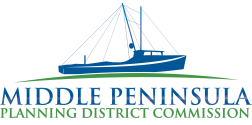* Working Waterfronts Coalition
For many Virginia rural coastal communities, there is a strong need to maximize the potential of the waterfront as a driver for economic vitality. However, market forces, changing demographics, and increasing tax burdens on waterfront properties are increasingly driving a transition of waterfront properties toward residential or recreational uses. In addition, regulatory changes affecting marine fisheries management are impacting water dependent industries and working waterfronts. If access to the waterfront is limited or severed, commercial and recreational fishermen, researchers, and other water-dependent businesses will have fewer options to successfully make a living from the tidal waters of the Commonwealth, including the Seaside on the Eastern shore. As a result, many rural Chesapeake Bay and Seaside communities are challenged to maintain their identity and are shifting away from water-dependent employment, causing economic and cultural changes that can limit economic diversification opportunities and fundamentally alter the nature of the communities themselves. These challenges are particularly acute in both rural Chesapeake Bay and Seaside coastal communities. In response, Accomack-Northampton PDC, Northern Neck PDC Middle Peninsula PDC, Middle Peninsula Chesapeake Bay Public Access Authority, Northern Neck Chesapeake Bay Public Access Authority and Marine Advisory Services at VIMS collectively propose to form a Rural Chesapeake Bay-Seaside Working Waterfront Coalition.
*Working Waterfronts Definition
In partnership with Marine Advisory Services at VIMS, MPPDC staff will coordinate a series of local meetings to identify key working waterfront business and develop a definition of working waterfronts unique to the Middle Peninsula.
*Perrin River
Within the Middle Peninsula, and most coastal communities nationwide, the commercial seafood industry has had to adapt and shift as coastal land use and waterfront property ownership have altered. Historically, as epicenters of economic development, coastal communities were the location of strong fisheries and shipbuilding industries, as well as public access areas for recreational and commercial uses. However, as more and more people move toward the coast, the coastal dynamics combined with changing demographics ultimately threaten traditional and culturally significant working waterfront industries (ie. commercial seafood). The Perrin River in particular needs a comprehensive plan to assess the needs of the commercial seafood industry, harbor management and current and future infrastructure. This project will develop a Commercial Seafood Harbor Master Plan and its implementation could ensure that current and future commercial watermen have access to infrastructure and business support services.
